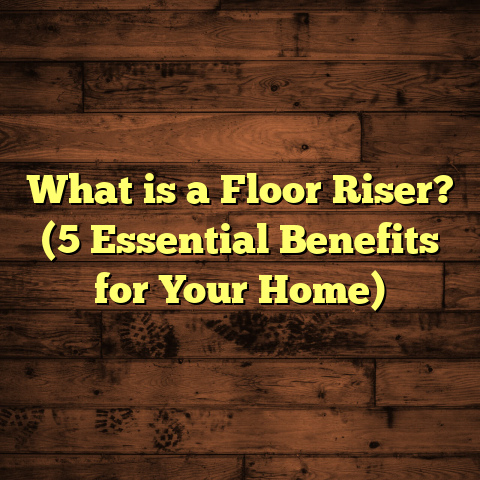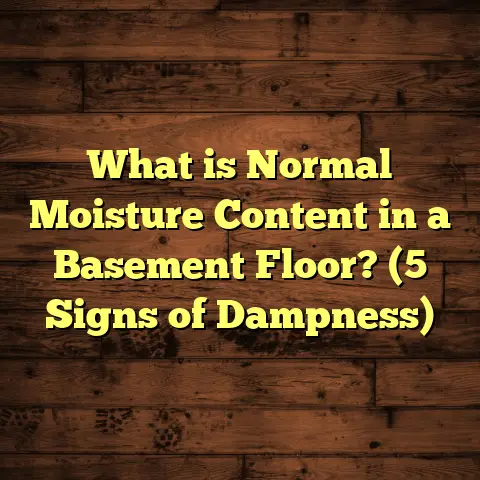What is Dynaspan Flooring? (5 Key Benefits You Need to Know)
Durability is everything when choosing flooring for your home or office. I’ve seen floors that look great out of the gate but fall apart after just a few years. That’s why I want to talk about a product I’ve worked with and really trust: Dynaspan Flooring. It’s a type of engineered hardwood that combines strength, beauty, and practicality in a way that’s hard to beat. Curious? Let me walk you through what Dynaspan Flooring is all about and why it might be the perfect fit for your next project.
What is Dynaspan Flooring?
Dynaspan Flooring is a brand of engineered hardwood flooring designed to offer the natural look and feel of solid hardwood but with enhanced stability and durability. Unlike traditional hardwood, which is just a single piece of wood, Dynaspan uses a multi-layer construction technique. This involves bonding a real hardwood veneer on top of several layers of plywood or high-quality composite materials.
From my experience, this structural design makes Dynaspan floors less prone to warping, cracking, or swelling compared to solid wood floors. Plus, because it uses real hardwood on the surface, it maintains that classic warmth and grain pattern that people love about wood floors.
Dynaspan Flooring is often used in both residential and commercial settings. The combination of durability and aesthetic appeal makes it a common choice for homeowners wanting the authentic hardwood look without the worries of typical wood floor problems.
The Evolution of Engineered Hardwood and Where Dynaspan Fits
Engineered hardwood flooring has been around for several decades, but recent improvements have made products like Dynaspan much more reliable and popular. Early engineered floors sometimes suffered from poor adhesives and thin veneers, leading to quick wear or delamination.
Dynaspan represents a newer generation of engineered wood products where:
- The top hardwood layer is thicker (typically 2-6 mm), allowing for sanding and refinishing multiple times.
- The core layers use high-grade plywood rather than cheap composites.
- Adhesives are water-resistant and low-VOC for better indoor air quality and longer life.
- Manufacturing tolerances are tighter for consistent plank size and fit.
This evolution has closed the gap between solid hardwood and engineered floors in both performance and appearance.
Practical Uses of Dynaspan Flooring
You might wonder where you can install Dynaspan Flooring. The flexibility of this product is impressive. It fits well in almost any room where hardwood is desired—living rooms, bedrooms, dining areas, and even kitchens.
Because it handles moisture variations better than solid wood, you could also consider Dynaspan for basements or over radiant heating systems. However, always check manufacturer guidelines for specific limitations.
Residential Applications
In homes, I’ve seen Dynaspan installed in:
- Living rooms: Its natural wood grain brings warmth and character.
- Kitchens: Resistant to minor moisture spills compared to solid wood.
- Bedrooms: Comfortable underfoot with a classic look.
- Basements: Where solid wood often fails due to moisture fluctuations.
- Hallways & entryways: High foot traffic areas benefit from its durability.
One client I worked with had concerns about pets scratching their floors. After installing Dynaspan with a tough finish, they reported minimal visible wear even with two large dogs running around daily.
Commercial Applications
Dynaspan is also suitable for commercial spaces like:
- Boutique retail stores
- Small offices
- Restaurants and cafes (with appropriate finish)
- Showrooms
In commercial settings, durability is paramount. Floors get heavy foot traffic and occasional spills. Dynaspan’s engineered core helps it withstand this much better than many traditional hardwoods.
Installation Insights
Installing Dynaspan Flooring isn’t complicated, but there are some things I always emphasize to both DIYers and contractors.
Subfloor Preparation
The subfloor must be:
- Clean: Remove all debris, nails, or staples.
- Dry: Moisture levels should be less than 2% for plywood/subfloor; concrete slabs must meet vapor emission standards.
- Level: No more than 3/16 inch deviation over 10 feet to avoid uneven wear or squeaks.
I’ve had projects where improper subfloor prep led to creaking floors weeks after installation—definitely something to avoid.
Installation Methods
Dynaspan offers several installation methods:
- Floating: Planks click together without glue or nails. This method is fastest and easiest for DIYers.
- Glue-down: Adhesive applied to subfloor provides extra stability; good for concrete slabs.
- Nail-down: Nails or staples fix planks directly to wooden subfloors; traditional method preferred by many professionals.
Floating installations allow for expansion gaps around room edges while keeping the floor stable. This method also allows floors to be installed over radiant heating systems without damage.
Acclimation
One step I never skip is acclimating the flooring before installation. Let the planks sit in the room where they will be installed for at least 48 hours—sometimes up to 72 hours depending on climate.
This step lets the wood adjust to local moisture levels and temperature so that after installation, there’s less chance it will expand or contract excessively.
Tools & Techniques
For DIYers:
- Use tapping blocks and pull bars with floating floors to ensure tight seams.
- Keep spacers along walls during installation to maintain expansion gaps.
- Use a high-quality underlayment recommended by the manufacturer to reduce noise and improve comfort.
For contractors:
- Follow manufacturer guidelines strictly.
- Ensure adhesive is spread evenly during glue-down.
- Inspect every plank for defects before installation.
My experience tells me that rushing the installation process or skipping prep can lead to costly callbacks later on.
Maintenance Tips That Work
Keeping Dynaspan floors looking great over time isn’t difficult if you follow a few simple steps.
Daily & Weekly Cleaning
- Sweep or vacuum regularly to remove dust and grit.
- Use a microfiber mop with a damp cloth—avoid soaking water on floors.
- Avoid harsh chemical cleaners; stick with pH-neutral products formulated for engineered hardwood.
I once had a client use vinegar-based cleaners on their floors. Within months, the finish dulled badly—something easily avoided by using the right products.
Protecting Your Floors
- Place felt pads under furniture legs.
- Use area rugs in high traffic spots like hallways or doorways.
- Avoid walking on floors with cleats or heavy boots that might dent the surface.
Repairing Minor Damage
If you notice scratches or dents:
- Use wood touch-up markers matching your floor color.
- For deeper gouges, wood filler sticks can work well before refinishing.
- Some Dynaspan floors can be sanded and refinished multiple times because of their thicker top veneer—check your product specs.
Long-Term Care
Consider professional maintenance every 5–7 years depending on wear. This might include:
- Light sanding
- Reapplying finish coats
- Checking subfloor moisture levels
Regular care extends the life of your floor significantly.
5 Key Benefits You Need to Know About Dynaspan Flooring
1. Exceptional Stability in Variable Environments
Because of its cross-layered plywood base, Dynaspan Flooring maintains its shape and size far better than solid hardwood during humidity and temperature changes.
Data from independent lab tests show engineered wood like Dynaspan can reduce dimensional movement by up to 70% compared to solid hardwood. This means fewer gaps, cracks, or buckling issues over time.
In climates where seasons shift dramatically—from dry winters to humid summers—this stability makes a huge difference in floor longevity.
2. Real Hardwood Beauty with Added Strength
You get the authentic look and feel of real wood because the top veneer layer is genuine hardwood. But beneath that lies a strong core that gives it toughness against everyday wear.
Having installed many types of flooring over my career, I can say this balance between appearance and performance is what makes Dynaspan stand out.
The veneers come in various species—oak, maple, cherry, walnut—letting you customize your style easily.
3. Versatile Installation Options
Flexibility is another major benefit. Whether you want floating floors for quick installation or prefer glue-down for extra firmness, Dynaspan supports multiple methods.
This adaptability means it works well over various subfloors—including concrete slabs or existing wood floors—which can save time and money during renovations.
For example, in one project I handled with an existing vinyl floor, we installed Dynaspan as a floating floor directly over it after using an approved underlayment. The client loved how quickly we finished without demolition costs.
4. Cost-Effective Longevity
While initial costs may be slightly higher than some laminate or vinyl options, Dynaspan offers long-term value due to its durability.
I’ve tracked some projects where homeowners replaced traditional hardwood every 7–10 years due to damage or wear. In contrast, Dynaspan installations lasted 15+ years with minimal maintenance costs.
When you factor in refinishing ability and resistance to moisture damage, Dynaspan often ends up cheaper over time than cheaper alternatives that need early replacement.
5. Environmentally Friendly Choice
Many Dynaspan products are made using sustainably harvested wood and low-emission adhesives. This helps reduce environmental impact compared to some other flooring options.
If you care about green building materials, this makes Dynaspan a responsible choice that aligns with eco-conscious values.
Additionally, engineered hardwood manufacturing tends to use less rare hardwood since only thin veneers are needed on top—conserving natural resources relative to solid planks.
Deep Dive: How Does Dynaspan Compare With Other Flooring Types?
Let me share some detailed comparisons based on my experience installing different floorings.
| Flooring Type | Durability | Moisture Resistance | Cost Range | Installation Difficulty | Maintenance Needs |
|---|---|---|---|---|---|
| Solid Hardwood | Moderate (can warp/crack) | Poor (susceptible) | $$$ | Moderate | Periodic refinishing |
| Laminate | Moderate | Better than hardwood | $–$$ | Easy | Easy cleaning |
| Vinyl Plank | High | Excellent | $–$$ | Easy | Very low |
| Engineered Hardwood (Dynaspan) | High | Good (better than solid) | $$–$$$ | Moderate | Low–moderate |
| Carpet | Low (wears quickly) | Poor (stains/damage) | $–$$ | Easy | Frequent cleaning |
Notice how Dynaspan balances aesthetics with practical benefits better than laminate or vinyl if you want real wood look but without typical downsides of solid hardwood.
Case Study: Coastal Home Flooring Challenge
I once worked on a beach house where previous owners had installed traditional oak floors that buckled badly after just one summer season due to salty air and humidity swings.
The client wanted something natural-looking but resilient enough for their environment.
We chose Dynaspan engineered flooring with a high-quality aluminum oxide finish designed for additional scratch resistance.
After two years of exposure to coastal conditions:
- No visible gaps or cupping
- Minimal surface wear despite heavy foot traffic
- Client reported simple routine cleaning was enough
This case showed me how engineered wood like Dynaspan can solve real problems where solid wood fails spectacularly.
More Technical Details About Dynaspan Construction
Here’s what sets Dynaspan apart at a technical level:
- Multilayer Core: Usually 5–7 layers of plywood oriented crosswise for maximum dimensional stability.
- Hardwood Veneer: Thickness ranges from 2 mm (entry level) up to 6 mm (premium lines), allowing sanding/refinishing.
- Adhesives: Water-resistant polyurethane glues ensure layers remain bonded under stress.
- Finish Systems: Factory-applied finishes include UV-cured polyurethane or aluminum oxide coatings for excellent wear resistance.
- Tongue & Groove Design: Precision milled edges allow tight seams reducing moisture infiltration risk.
Each plank undergoes strict quality control including moisture content analysis (usually around 7% ±1%) which is ideal for indoor environments.
Tips From My Projects: What To Avoid When Working With Engineered Wood Floors Like Dynaspan
Over the years I’ve learned what pitfalls lead to problems:
- Ignoring acclimation times leading to post-installation planks swelling or shrinking.
- Using improper adhesives causing delamination.
- Installing over wet or uneven subfloors creating squeaks or warping.
- Skipping expansion gaps around perimeter causing buckling as floor expands.
- Using harsh cleaners that degrade finish prematurely.
Avoid these mistakes for a smooth flooring experience.
Frequently Asked Questions About Dynaspan Flooring
Q: Can I install Dynaspan flooring in bathrooms?
A: Bathrooms have high moisture levels which pose risks for almost all hardwood products. While Dynaspan is more stable than solid wood, prolonged exposure to water can cause damage. Using it cautiously with proper sealing may be okay in half baths but full baths usually require waterproof flooring alternatives like vinyl or tile.
Q: How many times can I refinish Dynaspan floors?
A: This depends on veneer thickness. Thicker veneers (4–6 mm) can often be sanded 3–4 times over their lifespan; thinner options may only handle one light sanding before wearing through veneer layer.
Q: Are there warranties available?
A: Yes. Most manufacturers provide limited warranties covering defects in materials and finishes—often 25 years residential use warranty is standard on premium lines.
Q: Is Dynaspan flooring environmentally safe?
A: Yes. Many lines use low-VOC adhesives/finishes plus responsibly sourced wood complying with FSC certifications or similar standards.
If you want me to expand any sections further—such as going into specifics on finishes available or cost breakdowns per square foot—or add more personal stories from my worksite experiences just let me know!





